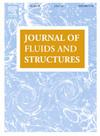Theoretical analysis of liquid wave motion in rotating cylinder depending on liquid depth ratio
IF 3.4
2区 工程技术
Q1 ENGINEERING, MECHANICAL
引用次数: 0
Abstract
The fluid force caused by the wave motion of liquid that partially fills a hollow rotor was theoretically investigated, with a focus on the motion's relationship with the radial liquid depth. The fluid force causes a self-excited whirl of the rotor. To obtain the excitation force as a function of the liquid depth, a nonlinear analysis method that does not use shallow water approximation is presented. Gravity is negligible and the liquid motion is assumed to be axially uniform. The linear eigenmodes of the two-dimensional flow in the radial and circumferential directions are nonlinearly coupled through the Galerkin method. The periodic solution of the wave response to the whirl motion is obtained and is compared with the conventional shallow water approximation. In the present theory, the excitation force reaches its maximum at a specific liquid depth that is consistent with previous experimental studies, while the maximum does not appear in the shallow water approximation. Furthermore, the present theory indicates that the response of the first eigenmode that causes the excitation force is suppressed by nonlinearity when the liquid is shallow; in contrast, when the liquid is deep, the first eigenmode self-balances with disturbance of the whirl motion without the help of nonlinearity. The decrease in the helping role of nonlinearity in a deep liquid comes from the ratio of the radial flow velocity to the circumferential flow velocity in the eigenfunction becoming large as the liquid depth ratio increases.
随液深比变化的旋转圆筒内液体波动的理论分析
从理论上研究了部分填充空心转子的液体的波动所引起的流体力,重点研究了波动与径向液体深度的关系。流体力使转子产生自激旋转。为了得到激励力随液深的变化规律,提出了一种不采用浅水近似的非线性分析方法。重力可以忽略不计,假定液体运动是轴向均匀的。利用伽辽金方法对二维流在径向和周向上的线性特征模态进行非线性耦合。得到了旋涡运动波浪响应的周期解,并与传统的浅水近似进行了比较。在本理论中,激发力在特定的液体深度达到最大值,这与以往的实验研究一致,而在浅水近似中没有出现最大值。此外,本理论还表明,当液体较浅时,引起激振力的第一特征模态响应被非线性抑制;相比之下,当液体较深时,第一特征模态在旋涡运动干扰下自平衡,不需要非线性的帮助。在深液中,非线性的帮助作用减小是因为特征函数中径向流速与周向流速之比随着液深比的增大而增大。
本文章由计算机程序翻译,如有差异,请以英文原文为准。
求助全文
约1分钟内获得全文
求助全文
来源期刊

Journal of Fluids and Structures
工程技术-工程:机械
CiteScore
6.90
自引率
8.30%
发文量
173
审稿时长
65 days
期刊介绍:
The Journal of Fluids and Structures serves as a focal point and a forum for the exchange of ideas, for the many kinds of specialists and practitioners concerned with fluid–structure interactions and the dynamics of systems related thereto, in any field. One of its aims is to foster the cross–fertilization of ideas, methods and techniques in the various disciplines involved.
The journal publishes papers that present original and significant contributions on all aspects of the mechanical interactions between fluids and solids, regardless of scale.
 求助内容:
求助内容: 应助结果提醒方式:
应助结果提醒方式:


